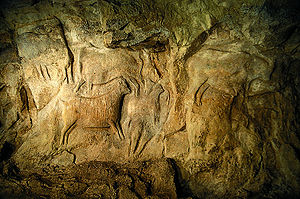
Roc-aux-Sorciers
Encyclopedia

Upper Paleolithic
The Upper Paleolithic is the third and last subdivision of the Paleolithic or Old Stone Age as it is understood in Europe, Africa and Asia. Very broadly it dates to between 40,000 and 10,000 years ago, roughly coinciding with the appearance of behavioral modernity and before the advent of...
rock shelter
Rock shelter
A rock shelter is a shallow cave-like opening at the base of a bluff or cliff....
site dating to the mid-Magdalenian
Magdalenian
The Magdalenian , refers to one of the later cultures of the Upper Paleolithic in western Europe, dating from around 17,000 BP to 9,000 BP...
cultural stage, ca 14000 yBP
Before Present
Before Present years is a time scale used in archaeology, geology, and other scientific disciplines to specify when events in the past occurred. Because the "present" time changes, standard practice is to use AD 1950 as the origin of the age scale, reflecting the fact that radiocarbon...
, made famous by its relief wall carvings. The site is in the French commune of Angles-sur-l'Anglin
Angles-sur-l'Anglin
Angles-sur-l'Anglin is a commune in the Vienne department in the Poitou-Charentes region in western France. It has been selected as one of the official most beautiful villages of France and contains castle ruins dating as far back as the 11th century originally constructed for the Bishop of...
, in Vienne
Vienne
Vienne is the northernmost département of the Poitou-Charentes region of France, named after the river Vienne.- Viennese history :Vienne is one of the original 83 departments, established on March 4, 1790 during the French Revolution. It was created from parts of the former provinces of Poitou,...
. The name 'Sorcerers' Rock', with its suggestions of pagan rendez-vous, was applied to the site long before the wall-carvings were discovered.
The south-facing rock-shelter at the base of the slopes of the Douce, above the right bank of the Anglin, about 1.5 km above the village, is composed of two geologically distinct sections; below is the Abri Bourdois, a classic rock-shelter site beneath a slight overhang, and above is the Cave Taillebourg, a deeper vestibule. The two parts are separated by a zone that has not yet been excavated, kept in reserve. The site was classed a Monument Historique
Monument historique
A monument historique is a National Heritage Site of France. It also refers to a state procedure in France by which national heritage protection is extended to a building or a specific part of a building, a collection of buildings, or gardens, bridges, and other structures, because of their...
, 18 January 1955.
Excavation history
The history of discoveries at Roc-aux-Sorciers begins in 1927, when Lucien Rousseau discovered the Paleolithic habitation and identified it as mid-Magdalenian in its culture. He began excavations in the Cave Taillebourg and recovered an engraved stone in which Henri Breuil detected the representation of a mammothMammoth
A mammoth is any species of the extinct genus Mammuthus. These proboscideans are members of Elephantidae, the family of elephants and mammoths, and close relatives of modern elephants. They were often equipped with long curved tusks and, in northern species, a covering of long hair...
. Some years later, Suzanne de Saint-Mathurin became aware of Rousseau's article and decided to explore further, hoping to find some incised plaquettes like those from the cave at Lussac-les-Châteaux
Lussac-les-Châteaux
Lussac-les-Châteaux is a commune in the Vienne department in the Poitou-Charentes region in western France.- Prehistory :The importance of the prehistoric art at Lussac is evidenced by the presence of numerous archaeological artefacts in the Museum of National Antiquities at...
, also in Vienne. Assisted by her friend Dorothy Garrod, she carried out a decade of intensive campaigns between 1947 and 1957, and followed more sporadically until 1964. The team discovered carved blocks with sculpted and incised figures, sometimes painted, of bison, horses, wild goats, felines and the figure of a man. It soon became clear that these fragments had fallen from the roof of the Cave Taillebourg. Only the carved and painted figure of a bison (illustration, right above) has remained in place.
The sculpted frieze was discovered from 1950. It is composed of bison, horses, wild goats, felines, and the headless and footless figures of women, of the type conventionally called Venuses
Venus figurines
Venus figurines is an umbrella term for a number of prehistoric statuettes of women portrayed with similar physical attributes from the Upper Palaeolithic, mostly found in Europe, but with finds as far east as Irkutsk Oblast, Siberia, extending their distribution to much of Eurasia, from the...
.
The sculpted frieze of the Abri Bourdois
The sculpted frieze is exceptional for the evidence it offers of the technical mastery of Magdalenian sculptors, for the anatomical details and the impression of power given to volumes in the play of firelight. Both animal and human figures strive for realism, a rarity in paleolithic art that reinforces the unique value of the site.The excavations brought to light the evidence of human occupation associated with this wall art, of a material culture represented in jewelry, lamps, and tools in flint, in bone and horn and in ivory. The frieze, some twenty metres in length, is an impressively monumental work of art. Numerous finely engraved figures show that graphic values could be expressed on an intimate scale as well.

